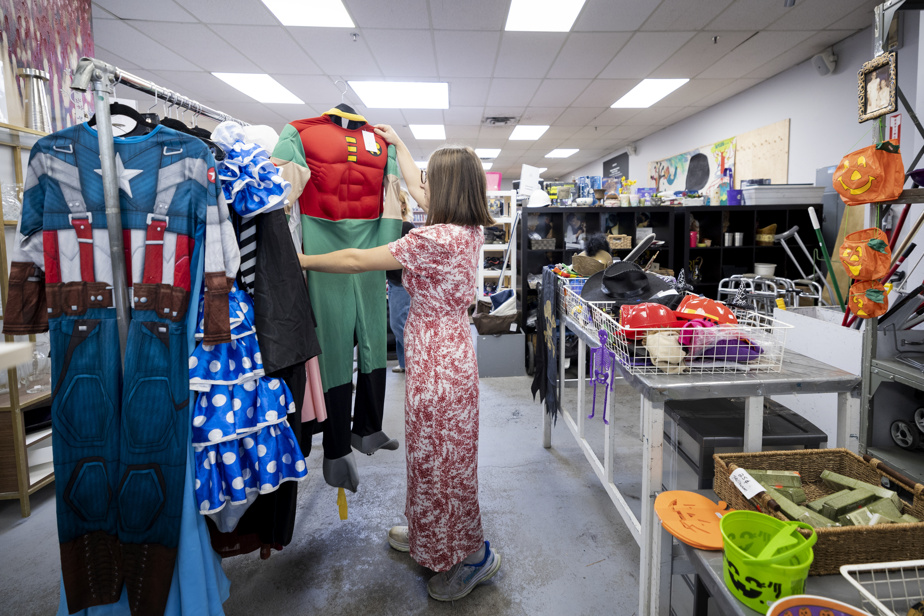A young librarian from Montreal came up with the idea of a Halloween flea market by looking at the fall activity calendars of major American libraries, which are organizing them. Élyse Noël-Gauthier, employee of the Marc-Favreau library in the Rosemont–La Petite-Patrie borough, said to herself: why not take inspiration from them, and implement a citizen concept of costume exchange here Halloween?
“Libraries are already practicing the circular economy with their mission of borrowing books and sports equipment. The tastes of young people evolve, they grow up. One year it’s Paw Patrol, now it’s Spider. Every year, it’s the costume race. The notion of barter could not be better applied than to disguises. »
Since the end of September, she has set in motion a pilot project for a community clearance sale in preparation for the big vigil of the little monsters. The principle is simple: you just need to bring a suit already worn, but clean, without tears or lost buttons. In exchange, the citizen receives a coupon valid for another costume during the big sale on Saturday, October 14.
Mme Noël-Gauthier believes that his pilot project should be successful, in an inflationary economic context and an awakening of ecological awareness. Surplus costumes will be offered to the population.

PHOTO FRANÇOIS ROY, THE PRESS
Élyse Noël-Gauthier, instigator of a Halloween costume exchange project in Rosemont–La Petite-Patrie
“Buying a new costume represents a big expense, not to mention the purchase of accessories, makeup, candy,” assesses the librarian.
Last year, spending on Halloween represented a total of $264 million in Quebec, a jump of 41.4% compared to 2021. Which means an average budget of around $70 per Halloween participant. party, according to data compiled by HelloSafe, a financial product comparison company. The firm explains that it does not intend to repeat the exercise this year, but it speaks of a constant increase in costs.
Costumes from $4 to $15 at Le Chaînon
In the aisles of the Le Chaînon store, boulevard Saint-Laurent, there is a large quantity of costumes for young and old. The range of accessories is impressive: hats, scarves, belts. There are decorations and the famous plastic buckets for collecting treats when going door to door. Profits from the store serve as the main source of financing for the mission of accommodation (room and board) and support for the women of Le Chaînon.

PHOTO MARCO CAMPANOZZI, THE PRESS
Last year, Halloween spending totaled $264 million in Quebec.
“I have a large bin of accessories at $2 each,” says Valérie Tondreau, marketing manager for the Le Chaînon store. We have costumes that sell for as little as $4, up to $15, but at the most. At our house, we receive costumes all year round. Around mid-September, we start preparing for Halloween. The decoration also takes up a lot of space. It’s a circular economy, Halloween is a good way to promote thrift stores. » In the organization’s shelters, Halloween parties will be organized thanks to donations.

PHOTO MARCO CAMPANOZZI, THE PRESS
Halloween costumes and accessories from the Le Chaînon store
In addition to the sale of costumes and accessories, the organization is working on a concept of upcycling workshops. “For example, we could teach our customers how to use an old scarf to design a flower pot. The possibilities in the world of suprarecycling are enormous,” argues M.me Tondreau.
Borrow
The Ville en Vert organization, whose mission is to support citizens and organizations in sustainable development, notes that a shift is taking place in terms of costumes. In Saint-Michel, Parc-Extension and Cartierville, it is possible to borrow costumes through the organization’s library tool. For example, at the Maison du Citoyen in Saint-Michel, you can borrow a dragon, dinosaur, fox or firefighter costume, all for a refundable deposit of $10.
